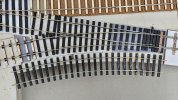You are using an out of date browser. It may not display this or other websites correctly.
You should upgrade or use an alternative browser.
You should upgrade or use an alternative browser.
7mm Heybridge Basin
- Thread starter Richard Gawler
- Start date
Richard Gawler
Western Thunderer
A more hare-brained idea for the point control is to into install solar cells below the surface of the water in the basin and use these to drive a stall motor on the Setrack point. Switching this from the spare changeover contacts on the Blue Point. This is definitely going down the route of "making work to show it can be done".
I will achieve much contentment if I can plonk the layout down at a show and run with dead track. It would be good to not need any mains power at all but I must remember the lighting rig.
I will achieve much contentment if I can plonk the layout down at a show and run with dead track. It would be good to not need any mains power at all but I must remember the lighting rig.
Richard Gawler
Western Thunderer
One nice surprise to come out of all this testing was seeing my Y14 negotiate the Setrack turnout. The model wouldn’t do this when the turnout was in its original condition.
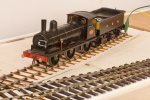
Now I have lopped 35 mm off the curved exit track and relaxed the radius of what remains, it does.
Both loco and tender will individually negotiate radius 2 curves, but the scale distance between them means the combined wheelbase has to be at least one axle’s worth longer than the curve.
I’m not suggesting the Y14 will become the Heybridge Basin pilot, but this might be useful all the same. Perhaps for getting the train engine out of the way after a through GER working.

Now I have lopped 35 mm off the curved exit track and relaxed the radius of what remains, it does.
Both loco and tender will individually negotiate radius 2 curves, but the scale distance between them means the combined wheelbase has to be at least one axle’s worth longer than the curve.
I’m not suggesting the Y14 will become the Heybridge Basin pilot, but this might be useful all the same. Perhaps for getting the train engine out of the way after a through GER working.
Richard Gawler
Western Thunderer
Richard Gawler
Western Thunderer
A mate brought two brass diesels round yesterday, a Bachmann class 24 and a San Cheng class 08, and both of these ran perfectly.
For the record, the layout has an 0-F turnout (the Setrack point) and 32 mm gauge plain track; and a 0-MF turnout, 0-MF inset track and 31.5 mm plain track; and of course the transitions between these.
My list of compatible wheelsets, all unmodified, is now the following:
The only obvious limitation came when I put 0-MF inset track very close to a Setrack turnout and ran a coach with a long-ish rigid wheelbase through this. So I reckon, 0-MF is a good thing; the track is within my abilities to build, and I can go for this for the common crossings and inset track (but probably not the toe ends of turnouts) on my layout of Heybridge itself when the time comes
Edited 7 April 2024 to add Ixion wheelsets.
For the record, the layout has an 0-F turnout (the Setrack point) and 32 mm gauge plain track; and a 0-MF turnout, 0-MF inset track and 31.5 mm plain track; and of course the transitions between these.
My list of compatible wheelsets, all unmodified, is now the following:
- Bachmann
- Dapol
- Gibson
- Ixion
- Minerva
- San Cheng
- Slater's
The only obvious limitation came when I put 0-MF inset track very close to a Setrack turnout and ran a coach with a long-ish rigid wheelbase through this. So I reckon, 0-MF is a good thing; the track is within my abilities to build, and I can go for this for the common crossings and inset track (but probably not the toe ends of turnouts) on my layout of Heybridge itself when the time comes

Edited 7 April 2024 to add Ixion wheelsets.
Last edited:
Extension Section for Sea Lock
New
Richard Gawler
Western Thunderer
I saved some offcuts of the iron-on veneers to use them on the extension for the sea lock. These veneers have a short storage life, perhaps three or four weeks. I wrapped the offcuts in cling flim and put them in the garden shed away from the central heating but they still curled up along their long axes. So when the kit to build the extension baseboard arrived, I built it straight away.
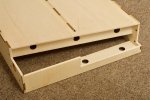
The baseboard is a standard module from Grainge and Hodder, 400 mm long and 400 mm deep, with the front cut away to make a space for the sea lock.
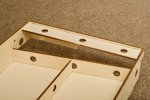
I have reinforced the front edge of the top and the slimmed-down front of the module with parts provided to use as diagonals.
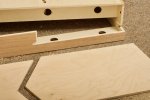
The structural bases for the sea lock (right) and the extension of the basin (left) are some 6 mm ply left over from another project. I cut locating slots in the frame not the new parts because this makes it so much easier to align the new parts.
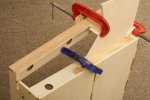
Fixing the extension of the basin. The block of softwood here is simply holding the base of the basin level, it is not a part of the model.
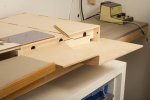
The idea is to make the course of the Navigation appear to curve to the right and drop away towards sea level.
The original idea was to put the lock gates at the baseboard joint, but this wouldn't work because the arm for working the gate of the sea lock would be crossing the headshunt. So this arm will be beyond the headshunt, near the pencil.
The veneers flattened themselves out quite well after I brought them back indoors, but they don't like being stored for any extended period.

The baseboard is a standard module from Grainge and Hodder, 400 mm long and 400 mm deep, with the front cut away to make a space for the sea lock.

I have reinforced the front edge of the top and the slimmed-down front of the module with parts provided to use as diagonals.

The structural bases for the sea lock (right) and the extension of the basin (left) are some 6 mm ply left over from another project. I cut locating slots in the frame not the new parts because this makes it so much easier to align the new parts.

Fixing the extension of the basin. The block of softwood here is simply holding the base of the basin level, it is not a part of the model.

The idea is to make the course of the Navigation appear to curve to the right and drop away towards sea level.
The original idea was to put the lock gates at the baseboard joint, but this wouldn't work because the arm for working the gate of the sea lock would be crossing the headshunt. So this arm will be beyond the headshunt, near the pencil.
The veneers flattened themselves out quite well after I brought them back indoors, but they don't like being stored for any extended period.
Richard Gawler
Western Thunderer
I am trying cabinet maker's dowels for aligning the extension. These are cheaper than pattern maker's dowels and easier to fit. Also the pattern maker's dowels are out of stock at Station Road Baseboards (stationroadbaseboards.co.uk) at the moment.
I want to keep the length of the main baseboard unchanged to help crating up, so the dowels are going onto the extension with their sockets onto the main basebard.
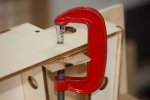
I used a 1/4 inch drive socket to press the dowels home, the socket is pressing on the shoulder of the dowel and cannot harm the tip. This is much better than trying to hammer them in
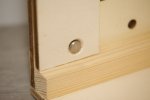
The holes are drilled 7.5 mm clear for 8 mm dowels, so putting a countersink stops the inside surface of the ply breaking away.
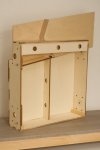
The baseboard is really strong and there doesn't seem to be any need for diagonals. These baseboard kits are so easy to put together and to modify I doubt I will ever try to build a ply baseboard from scratch again.
I want to keep the length of the main baseboard unchanged to help crating up, so the dowels are going onto the extension with their sockets onto the main basebard.

I used a 1/4 inch drive socket to press the dowels home, the socket is pressing on the shoulder of the dowel and cannot harm the tip. This is much better than trying to hammer them in


The holes are drilled 7.5 mm clear for 8 mm dowels, so putting a countersink stops the inside surface of the ply breaking away.

The baseboard is really strong and there doesn't seem to be any need for diagonals. These baseboard kits are so easy to put together and to modify I doubt I will ever try to build a ply baseboard from scratch again.
Richard Gawler
Western Thunderer
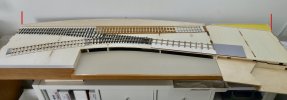
I want to have a demountable backscene, this extending between the two red markers here.
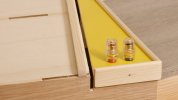
I have cut a slot in the back of the extension baseboard to hold this backscene. The strip of square softwood here is reinforcing the top of the baseboard. There is room for a landscape profile panel between this strip and the slot.
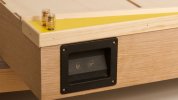
Behind this is a “tool storage area”, really just a place to keep the uncoupling hook and be able to see it from a distance. The two terminal posts are here to connect a controller to the layout or to connect the track to something else e.g. a rolling road, and the escutcheon plate is for controls for the lighting rig. These parts came from a pair of hi-fi loudspeakers found in a charity shop, all the drivers were shot

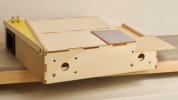
For the avoidance of doubt I really am making this up as I go along, but at the moment I am still pleased with what I making.
Last edited:
Richard Gawler
Western Thunderer
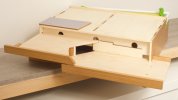
I have added the fascia strips for the basin and the sea lock.
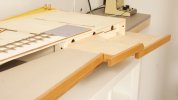
The idea is to suggest a waterway turning towards the viewer and dropping away from the basin towards the sea. This is my first attempt at using gaps between parts to try to improve the finished look of something.
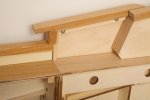
All the parts are fixed with wood glue, and there are screws where things looked vulnerable.
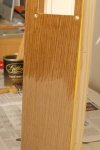
I have finished the oak parts with two coats of Gilboy’s hard wax oil (first coat in progress here), with these followed by a wax polish from the same company.
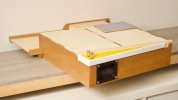
Quite a lot of effort to extend a headshunt by 150 mm!
I guess I have now built the frame for a non-existent artwork, and this may be doing things exactly the wrong way round i.e. I should build the model first. But this approach lets me have an arty shape to the front of the model. I am glad the structural woodwork is complete (it seems to have taken ages), and the extension does make the whole model more balanced.
oldravendale
Western Thunderer
Personally, as someone who's not built an operating layout for at least 40 years, I'd say you have it exactly the right way round. The layout should fit the scenery, not the other way round. If things don't fit hire a team of Irish navvies. 
Brian

Brian
Richard Gawler
Western Thunderer
As this diorama progresses, I am starting to think of it as my "portable" 0 gauge layout, while my model of Heybridge itself could be a strictly "home" layout. My trouble is, what I really want to build is a conventional 2.5 x 0.5 or so metre plank, but placed across the diagonal of a sheet of 8 x 4 board. Masses of space for scenery and potential for photography, but really unwieldy to ever take anywhere.
magmouse
Active Member
what I really want to build is a conventional 2.5 x 0.5 or so metre plank, but placed across the diagonal of a sheet of 8 x 4 board.
Exactly this. i completely understand why people build “plank” layouts - they are practical, and for some people modelling what happens beyond the railway fence isn’t a priority. But I’m like you, I think - I want Pendon, or at least the Madder Valley, with the railway in the scene.
Nick.
Richard Gawler
Western Thunderer
But I’m like you, I think - I want Pendon, or at least the Madder Valley, with the railway in the scene.
The nature of the Heybridge Railway is much nearer to the Madder Valley end of the spectrum. Like John Ahern, I will explain almost any anomaly by pointing out the line is run on light railway principles

Richard Gawler
Western Thunderer
I have taken Heybridge Basin as far as I want to for the time being, so here is a fresh mock-up to wrap things up for a while.

From the right:
Road vehicle - sets period
Wine corks - entrance gateway
Blue paint - single sleeper tied across rails
Yellow paint - ground frame
Red paint - sleeper-built buffer stop
The extension to the headshunt lets the Y14 shunt a wagon into the goods yard, and lets a tank engine shunt two.
The buildings of Heybridge Basin will have to go onto the back scene, there just isn’t space to make even the Ship pub without things looking crowded.
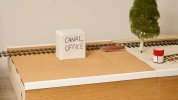
A possible option is to put a 400 mm module at the left. I like this, there is space to model freight awaiting loading onto train or barge. There could be a gravelled roadway with a level crossing (sandpaper) to hide the baseboard joint too. The more landscape I put each end of the main baseboard, the more spacious the setting becomes, but the whole layout would have to swing out into the middle of the room to attach the fiddle yard. There's another project!

From the right:
Road vehicle - sets period
Wine corks - entrance gateway
Blue paint - single sleeper tied across rails
Yellow paint - ground frame
Red paint - sleeper-built buffer stop
The extension to the headshunt lets the Y14 shunt a wagon into the goods yard, and lets a tank engine shunt two.
The buildings of Heybridge Basin will have to go onto the back scene, there just isn’t space to make even the Ship pub without things looking crowded.

A possible option is to put a 400 mm module at the left. I like this, there is space to model freight awaiting loading onto train or barge. There could be a gravelled roadway with a level crossing (sandpaper) to hide the baseboard joint too. The more landscape I put each end of the main baseboard, the more spacious the setting becomes, but the whole layout would have to swing out into the middle of the room to attach the fiddle yard. There's another project!

